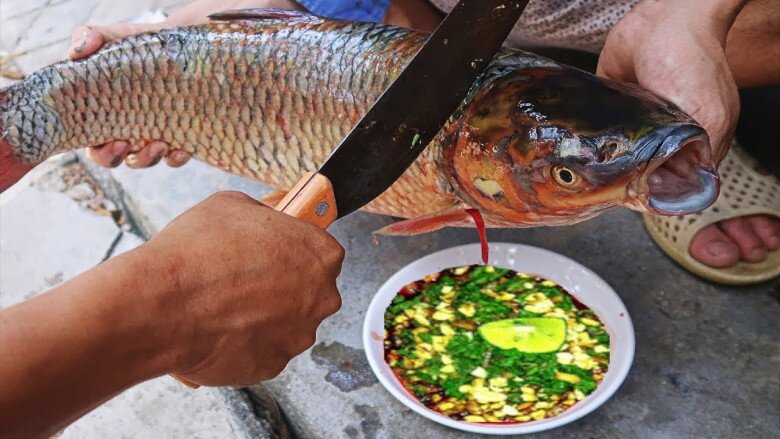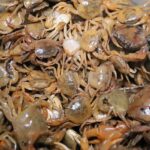Fish blood pudding is an unusual delicacy in northern Vietnam, specifically in the mountainous regions of Son La, Lai Chau, and Lao Cai. It is not a common dish and is considered a rare treat, often reserved for special occasions and honored guests.

Preparing fish blood pudding is a delicate and skilled process. The fish used must be large, preferably weighing 2kg or more, as the amount of blood increases with the size of the fish, resulting in a more aesthetically pleasing dish with a milder flavor. The ideal fish is the grass carp, which is often farmed in natural ponds without industrial feed to retain the natural sweetness of its meat and blood.

The key to this dish lies in the precise and swift technique of drawing the fish’s blood without allowing any water to mix with it. Even a single drop of water can prevent the blood from coagulating properly and may impart an unpleasant fishy odor. This critical step requires experience and dexterity.
While the blood is the show-stopping element, the “soul” of the dish lies in its filling or “core.” Locally known as “cot,” it is typically made with fried minced meat from rohu fish. The fish is first steamed, then the meat is carefully separated, fried to enhance its flavor, and finally spread evenly in a bowl. Immediately after drawing the fish’s blood, it is poured over the hot filling, creating a harmonious blend of textures and flavors.

As the dish sets, the blood coagulates into a soft, bright red layer atop the fragrant and fatty filling. It is traditionally served with roasted peanuts, basil, and shiso, accompanied by fresh lime and corn wine, a specialty of the region.
A Controversial Delicacy
Despite its status as a regional specialty, fish blood pudding has sparked controversy on social media. Videos showcasing its preparation have elicited a range of reactions, from surprise to outright fear. Some commenters express their reluctance to even consider tasting it, while others joke that one needs the bravery of an army recruit to give it a try.
However, there are also voices defending the dish, arguing that it is not dissimilar to other animal blood puddings and that it represents a unique aspect of local cuisine when prepared hygienically and correctly.

Medical experts, however, caution against consuming dishes made with raw blood, whether from fish or other animals. They emphasize the potential health risks associated with such dishes, including the presence of parasites, bacteria such as Streptococcus suis, and dangerous viruses. Fish from natural ponds, in particular, may carry higher levels of bacteria if not properly handled. The experts strongly advise adhering to the principle of “thorough cooking and boiling” and prioritizing food safety over adventurous culinary experiences.
Fish blood pudding exemplifies the adventurous and diverse nature of northern Vietnam’s cuisine. While it may be a cultural shock to those from other regions, it holds a special place in the local culinary heritage, symbolizing hospitality and regional pride. However, in the context of increasing emphasis on food safety, preserving culinary traditions must go hand in hand with scientific knowledge and community awareness. While a dish may be unique, its enjoyment should never come at the cost of one’s health.
Fish blood pudding is not for the faint-hearted, and perhaps even more so, not for the weak-stomached. However, even witnessing its preparation and understanding its significance in the local culture can offer a fascinating glimpse into the vibrant and diverse culinary landscape of Vietnam, shaped by its history and geography.
From Country Fence to City Feast: The Wild Hibiscus Flower’s Gourmet Transformation
In an era of fusion cuisine, there’s a growing appetite for simple, rustic dishes that evoke childhood memories. The leaves and young shoots of the hibiscus plant, once a common sight along fences, are now sought-after delicacies in online markets, fetching prices as high as 50,000 VND per kilogram.














